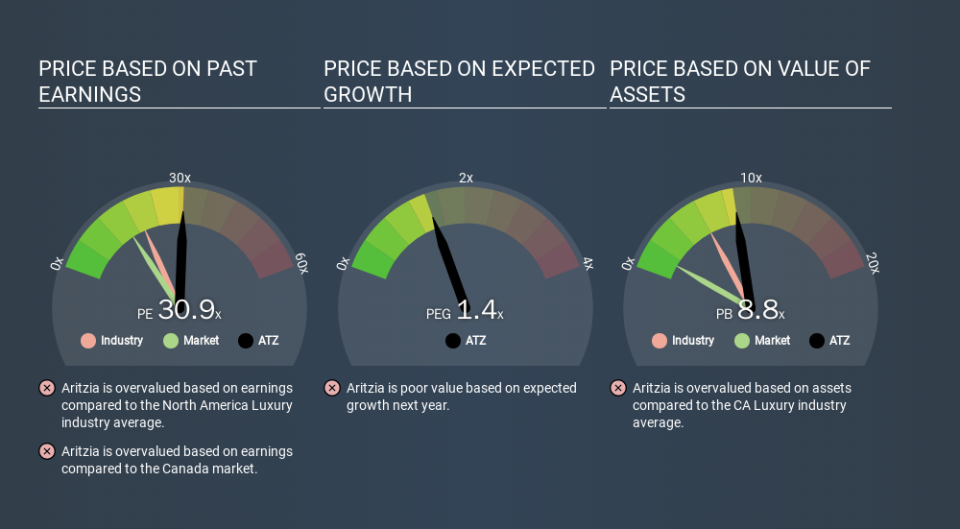How Does Aritzia's (TSE:ATZ) P/E Compare To Its Industry, After Its Big Share Price Gain?

The Aritzia (TSE:ATZ) share price has done well in the last month, posting a gain of 31%. Looking back a bit further, we're also happy to report the stock is up 55% in the last year.
All else being equal, a sharp share price increase should make a stock less attractive to potential investors. While the market sentiment towards a stock is very changeable, in the long run, the share price will tend to move in the same direction as earnings per share. So some would prefer to hold off buying when there is a lot of optimism towards a stock. Perhaps the simplest way to get a read on investors' expectations of a business is to look at its Price to Earnings Ratio (PE Ratio). A high P/E implies that investors have high expectations of what a company can achieve compared to a company with a low P/E ratio.
See our latest analysis for Aritzia
Does Aritzia Have A Relatively High Or Low P/E For Its Industry?
We can tell from its P/E ratio of 30.91 that there is some investor optimism about Aritzia. As you can see below, Aritzia has a higher P/E than the average company (19.8) in the luxury industry.
That means that the market expects Aritzia will outperform other companies in its industry. Clearly the market expects growth, but it isn't guaranteed. So further research is always essential. I often monitor director buying and selling.
How Growth Rates Impact P/E Ratios
Probably the most important factor in determining what P/E a company trades on is the earnings growth. Earnings growth means that in the future the 'E' will be higher. And in that case, the P/E ratio itself will drop rather quickly. So while a stock may look expensive based on past earnings, it could be cheap based on future earnings.
Aritzia increased earnings per share by an impressive 18% over the last twelve months. And it has bolstered its earnings per share by 53% per year over the last five years. With that performance, you might expect an above average P/E ratio.
Don't Forget: The P/E Does Not Account For Debt or Bank Deposits
Don't forget that the P/E ratio considers market capitalization. In other words, it does not consider any debt or cash that the company may have on the balance sheet. In theory, a company can lower its future P/E ratio by using cash or debt to invest in growth.
Spending on growth might be good or bad a few years later, but the point is that the P/E ratio does not account for the option (or lack thereof).
So What Does Aritzia's Balance Sheet Tell Us?
The extra options and safety that comes with Aritzia's CA$21m net cash position means that it deserves a higher P/E than it would if it had a lot of net debt.
The Bottom Line On Aritzia's P/E Ratio
Aritzia has a P/E of 30.9. That's higher than the average in its market, which is 15.8. Its strong balance sheet gives the company plenty of resources for extra growth, and it has already proven it can grow. So it does not seem strange that the P/E is above average. What is very clear is that the market has become significantly more optimistic about Aritzia over the last month, with the P/E ratio rising from 23.6 back then to 30.9 today. If you like to buy stocks that have recently impressed the market, then this one might be a candidate; but if you prefer to invest when there is 'blood in the streets', then you may feel the opportunity has passed.
Investors have an opportunity when market expectations about a stock are wrong. People often underestimate remarkable growth -- so investors can make money when fast growth is not fully appreciated. So this free report on the analyst consensus forecasts could help you make a master move on this stock.
But note: Aritzia may not be the best stock to buy. So take a peek at this free list of interesting companies with strong recent earnings growth (and a P/E ratio below 20).
If you spot an error that warrants correction, please contact the editor at editorial-team@simplywallst.com. This article by Simply Wall St is general in nature. It does not constitute a recommendation to buy or sell any stock, and does not take account of your objectives, or your financial situation. Simply Wall St has no position in the stocks mentioned.
We aim to bring you long-term focused research analysis driven by fundamental data. Note that our analysis may not factor in the latest price-sensitive company announcements or qualitative material. Thank you for reading.



